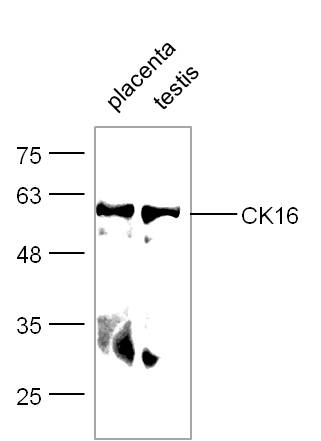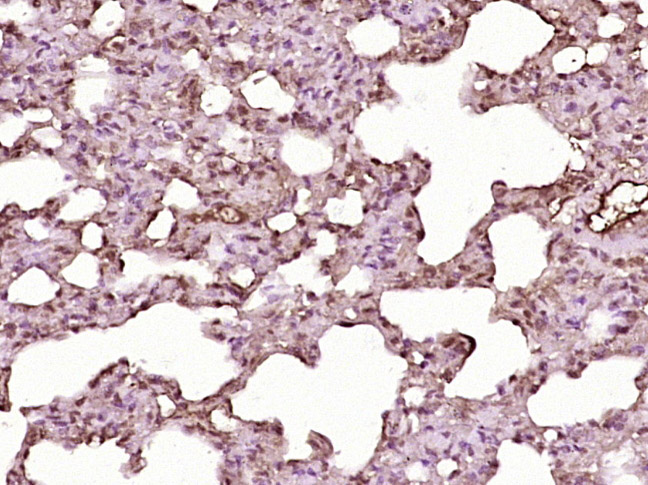
Rabbit Anti-CK16 antibody
Cytokeratin 16; CK 16; Focal non epidermolytic palmoplantar keratoderma; K 16; K16; K1CP; CK-16; CK16; Cytokeratin-16; FNEPPK; K1C16_HUMAN; Keratin; Keratin-16; type I cytoskeletal 16; Keratin 16; Keratin type I cytoskeletal 16; Keratin16; KRT 16; KRT16;
View History [Clear]
Details
Product Name CK16 Chinese Name 细胞角蛋白16抗体 Alias Cytokeratin 16; CK 16; Focal non epidermolytic palmoplantar keratoderma; K 16; K16; K1CP; CK-16; CK16; Cytokeratin-16; FNEPPK; K1C16_HUMAN; Keratin; Keratin-16; type I cytoskeletal 16; Keratin 16; Keratin type I cytoskeletal 16; Keratin16; KRT 16; KRT16; KRT16A; NEPPK. Research Area Tumour Signal transduction Cytoskeleton Immunogen Species Rabbit Clonality Polyclonal React Species Human, Mouse, Rat, (predicted: Dog, Cow, Horse, ) Applications WB=1:500-2000 ELISA=1:5000-10000 IHC-P=1:100-500 IHC-F=1:100-500 IF=1:100-500 (Paraffin sections need antigen repair)
not yet tested in other applications.
optimal dilutions/concentrations should be determined by the end user.Theoretical molecular weight 51kDa Cellular localization cytoplasmic Form Liquid Concentration 1mg/ml immunogen KLH conjugated synthetic peptide derived from human CK16: 371-473/473 Lsotype IgG Purification affinity purified by Protein A Buffer Solution 0.01M TBS(pH7.4) with 1% BSA, 0.03% Proclin300 and 50% Glycerol. Storage Shipped at 4℃. Store at -20 °C for one year. Avoid repeated freeze/thaw cycles. Attention This product as supplied is intended for research use only, not for use in human, therapeutic or diagnostic applications. PubMed PubMed Product Detail The protein encoded by this gene is a member of the keratin gene family. The keratins are intermediate filament proteins responsible for the structural integrity of epithelial cells and are subdivided into cytokeratins and hair keratins. Most of the type I cytokeratins consist of acidic proteins which are arranged in pairs of heterotypic keratin chains and are clustered in a region of chromosome 17q12-q21. This keratin has been coexpressed with keratin 14 in a number of epithelial tissues, including esophagus, tongue, and hair follicles. Mutations in this gene are associated with type 1 pachyonychia congenita, non-epidermolytic palmoplantar keratoderma and unilateral palmoplantar verrucous nevus. [provided by RefSeq, Jul 2008].
Subunit:
Heterodimer of a type I and a type II keratin. KRT16 associates with KRT6 isomers. Interacts with TCHP. Interacts with TRADD.
Tissue Specificity:
Expressed in the hair follicle, nail bed and in mucosal stratified squamous epithelia and, suprabasally, in oral epithelium and palmoplantar epidermis. Also found in luminal cells of sweat and mammary gland ducts.
DISEASE:
Pachyonychia congenita 1 (PC1) [MIM:167200]: An autosomal dominant ectodermal dysplasia characterized by hypertrophic nail dystrophy resulting in onchyogryposis (thickening and increase in curvature of the nail), palmoplantar keratoderma, follicular hyperkeratosis, and oral leukokeratosis. Hyperhidrosis of the hands and feet is usually present. Note=The disease is caused by mutations affecting the gene represented in this entry.
Keratoderma, palmoplantar, non-epidermolytic, focal (FNEPPK) [MIM:613000]: A dermatological disorder characterized by non-epidermolytic palmoplantar keratoderma limited to the pressure points on the balls of the feet, with later mild involvement on the palms. Oral, genital and follicular keratotic lesions are often present. Note=The disease is caused by mutations affecting the gene represented in this entry.
Unilateral palmoplantar verrucous nevus (UPVN) [MIM:144200]: UPVN is characterized by a localized epidermolytic hyperkeratosis in parts of the right palm and the right sole, following the lines of Blaschko. Note=The disease is caused by mutations affecting the gene represented in this entry.
Note=KRT16 and KRT17 are coexpressed only in pathological situations such as metaplasias and carcinomas of the uterine cervix and in psoriasis vulgaris.
Similarity:
Belongs to the intermediate filament family.
SWISS:
P08779
Gene ID:
3868
Database links:Entrez Gene: 3868 Human
Omim: 148067 Human
SwissProt: P08779 Human
Unigene: 655160 Human
Product Picture
Placenta(Mouse) Lysate at 30 ug
Testis (Mouse) Lysate at 30 ug
Primary:Anti-CK16 (SL1270R) at 1:300 dilution;
Secondary: HRP conjugated Goat-Anti-rabbit IgG(SL0295G-HRP) at 1: 5000 dilution;
Predicted band size: 51 kD
Observed band size: 55 kDParaformaldehyde-fixed, paraffin embedded (rat lung tissue); Antigen retrieval by boiling in sodium citrate buffer (pH6.0) for 15min; Block endogenous peroxidase by 3% hydrogen peroxide for 20 minutes; Blocking buffer (normal goat serum) at 37°C for 30min; Antibody incubation with (CK16) Polyclonal Antibody, Unconjugated (SL1270R) at 1:400 overnight at 4°C, followed by operating according to SP Kit(Rabbit) (sp-0023) instructionsand DAB staining.
References (0)
No References
Bought notes(bought amounts latest0)
No one bought this product
User Comment(Total0User Comment Num)
- No comment




 +86 571 56623320
+86 571 56623320
 +86 18668110335
+86 18668110335

